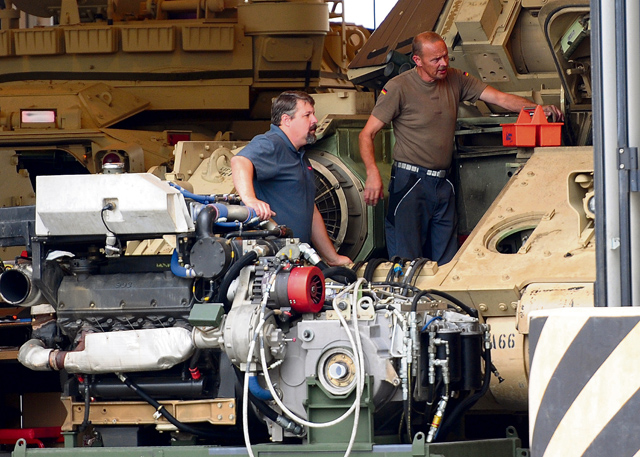
Contractors from the Coleman Worksite conduct maintenance on a Bradley Fighting Vehicle during the U.S. Army Europe Sustainment Terrain Walk Sept. 1.
MANNHEIM, Germany — Key leaders from the 21st Theater Sustainment Command, U.S. Army Europe and NATO partners conducted a whirlwind Sustainment Terrain Walk Sept. 1 to 3, stopping at more than a dozen logistics sites throughout the KMC and elsewhere in Europe.
The Sustainment Terrain Walk provided an opportunity for the leadership of USAREUR, NATO countries and other regional partners to assess the capabilities of several key logistics sites in Germany, Latvia and Poland that may be used in support of future NATO and partner nation operations.
The terrain walk began with the key leaders visiting the European Activity Set at the Coleman Worksite. The EAS is the Brigade Combat Team’s worth of equipment, pre-staged and maintained at the worksite in order to enable the U.S. Army’s new rotational forces concept.
The terrain walk also included stops at the Kaiserslautern Army Depot, Rhine Ordnance Barracks, Miesau Army Depot and other sites located within the KMC area of responsibility.
The leaders continued to Bremer-haven and Nordenham in Germany before traveling to Riga, Latvia. All three of these sites are critical seaports that are used regularly in support of NATO operations.
The final stop of the terrain walk was Drawsko Pomorskie, Poland, which is used as a training area for Operation Atlantic Resolve. OAR demonstrates continued U.S. commitment to the collective security of NATO and to the enduring peace and stability in the region.
USAREUR is leading the OAR-enhanced land force, multinational training and security cooperation activities that are taking place across Estonia, Latvia, Lithuania, Poland, Romania and Bulgaria. These activities build multinational interoperability; strengthen relationships and trust among allied armies; contribute to regional stability; and demonstrate the United States’ commitment to NATO.
The information gathered during the terrain walk will be used to develop procedures to support OAR, the EAS, rotational forces and other U.S. efforts in support of NATO.
According to USAREUR Commanding General, Lt. Gen. Ben Hodges, the U.S. Army’s current challenge in Europe is to accomplish, with limited resources, the same mission that massive formations of troops accomplished in years past.
“Years ago the United States had 300,000 troops in Europe,” Hodges said. “Our mission was to deter aggression. Now we have 30,000. Our mission is still to deter aggression. Our task now is to take the 30,000 and make them act like we have 300,000.”


